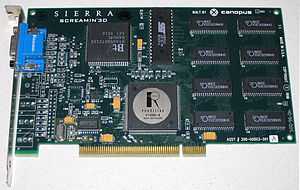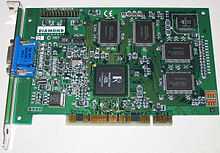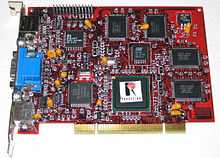Rendition (company)
| Type | Corporation |
|---|---|
| Industry | PC Multimedia Products |
| Founded | 1993 |
| Headquarters | Mountain View, California |
| Website | www.rendition.com (closed down) |
Rendition was a maker of 3D computer graphics chipsets in the mid to late 1990s. They were known for products such as the Vérité 1000 and Vérité 2x00 and for being one of the first 3D chipset makers to directly work with Quake developer John Carmack to make a hardware-accelerated version of the game (vQuake). Rendition's major competitor at the time was 3Dfx. Their proprietary rendering API's were Speedy3D (for DOS) and RRedline (for Windows).
3D Chipsets
Vérité V1000

Released in 1996, Rendition's V1000 chipset was notable for its RISC-based architecture. The V1000 was one of the first consumer 3D accelerator cards truly capable of delivering playable performance with significantly improved graphics quality. UNIX/workstations had long used intelligent coprocessor/microprocessor boards to accelerate display processing. The V1000 was the first PC graphics controller to utilize a programmable core to render 3D graphics. V1000 was both faster and more advanced (in terms of features) than competitors such as the Matrox Millennium, ATI Rage/3D, and S3 Virge3D. Only 3DFX's Voodoo Graphics was faster, but unlike the 3DFX Voodoo, the V1000 included 2D/VGA capability making it the only acceptably fast single-board solution for 3D gaming.
Vérité supported a local framebuffer of up to 4 MB EDO DRAM, on a 64-bit bus (for a theoretical 400 MB/s bandwidth). Aside from 3D gaming, Vérité contained an IBM VGA compatible display controller, and served as a traditional 2D/GUI accelerator for the Windows operating system.
In 1995, before it had shipped, Vérité received a marketing boon from board partner Number Nine Visual Technology:
"We at id have been fans of the Vérité architecture since we first saw the spec, several months back." stated John Carmack, technical director of id Software, creators of the popular action game Doom. "Now that we have some experience with the chip, we're even more pleased with it; in fact, it's our clear favorite among 3D accelerators." In discussing the development of their next generation software title QUAKE(tm), John goes on to say "... Vérité will be the premier platform for Quake."
(Ironically, Number Nine later cancelled their Vérité products. And in the book Masters of Doom, Carmack cited bad experiences with programming the Vérité as the reason for id's shift away from proprietary APIs toward the industry-standard OpenGL.)
The V1000 was fairly popular when it was launched. At least 3 companies sold Vérité boards: the Creative Labs 3D Blaster PCI, the Sierra Screamin' 3D, the Canopus Total 3D, and the Intergraph Reactor (later renamed Intense 3D 100). A handful of software titles shipped with V1000 support. As the ATI Rage/3D, S3 Virge/3D, and Matrox Mystique delivered 3D/graphics of questionable benefit, id Software's vQuake and Eidos's Tomb Raider were influential in fueling consumer interest in 3D/gaming hardware. The Vérité (and Voodoo) ports added 16-bit color rendering, bilinear filtering, per-polygon MIP mapping, and edge anti-aliasing to the game's 3D visuals. Released in time for Christmas 1996, both vQuake and Tomb Raider demonstrated the V1000's 3D/hardware to be both faster and better-looking than software rendering on even the most powerful host CPU.
An interesting piece of V1000's technology was its use of bus master DMA transfers for data transfer across the PCI bus. This allowed the board to transfer data much more efficiently than with the alternative FIFO mode of the bus. Unfortunately, the immaturity of the PCI bus at the time, and the limited use of bus mastering in general in systems of the day, caused DMA bugs to surface with Vérité. If a motherboard chipset wasn't capable of DMA, Vérité was forced to operate in FIFO mode and performance dropped dramatically. Additionally, on some motherboards, DMA support was incomplete or improperly implemented and speed was quite poor. Both of these issues combined to cause frequent problems for owners of the V1000. Rendition had a DMA test utility to benchmark a motherboard's support of DMA transfers. Some DOS games with Speedy3D Vérité support, such as IndyCar Racing II, offered a mode using DMA and a mode using FIFO, in order to bypass these issues.
The Vérité performed triangle setup in hardware. Rendition frequently touted its setup engine as an advantage against 3Dfx's Voodoo Graphics, because hardware setup reduced the host CPU's processing requirements for drawing complex 3D scenes. Unfortunately, the Vérité's 3D/engine lacked the necessary fill rate to capitalize on this advantage; the V1000's pixel fill rate was, at best, roughly 25Mpixels/second (little more than half that of the Voodoo Graphics.) Design limitations prevented V1000 from sustaining that level in many games (e.g. when the software uses z-buffering). While the Voodoo did become the accelerator of choice for high-budget 3D/gamers, the V1000's triangle setup and integrated 2D/VGA core attracted many gamers looking to upgrade on a modest budget.
Outside of 3D/gaming, V1000's (2D) performance was subpar in almost every way. On the extreme, in regular MCGA/VGA resolution or "Mode X", the V1000's performance was embarrassingly slow; older MS-DOS games (such as Doom) ran at near slideshow speeds, even on a top-of-the-line host CPU (Pentium 166 MHz). Rendition introduced "renutil", an MS-DOS utility, to address performance in MCGA graphics mode. The utility redirected MCGA (VGA-compatible) display mode setup to an equivalent VESA display mode, bypassing the Vérité's slow VGA core. The utility worked with all MCGA games, but was completely incompatible with games using "Mode X" VGA display mode, which could not be emulated using the VESA mode. Within Windows 95, the V1000 was passable, scoring neither top nor bottom in ZDnet's benchmark suite. In VESA VBE 2.0 display mode, Vérité's speed was outstanding, comparable to other top-rated cards of the era (such as the Matrox and ARK Logic PCI VGA chipsets.)
While Rendition had tried to craft the V1000 to support many application programming interfaces (APIs), these APIs were in their infancy at the time. For example, Microsoft's Direct3D standard was in rapid development with major changes occurring. V1000 was not optimized for this new Direct3D standard. However, this was more the fault of the API because Direct3D, at the time, lacked support for DMA transfers. The design of V1000, with its RISC core, was one of programmability. Because the GPU was not "hardwired" as ASICs are, the chip could potentially adapt to newer or differing standards than it was initially designed for. Performance limitations, however, inevitably dictated that the chip was not able to grow significantly. OpenGL support, for example, was very limited on V1000.
Vérité V2x00


Rendition's 2nd generation architecture consisted of the Vérité V2100 and V2200. The chips were refined versions of the V1000 technology, most notably offering a single-cycle pixel computation (the V1000 took more than a single clock cycle to calculate each pixel). This boosted the chips' fillrate nearly twofold, and combined with faster memory and a slightly faster core clock rate, offered performance modestly ahead of 3Dfx Voodoo Graphics (the benchmark of the time).
These two chips were identical in every way other than clock speed, with the V2100 being used as a "value"-oriented chip. V2100 was typically clocked at 40-45 MHz, while V2200 was typically seen at 55-60 MHz. The V2100 only saw implementation on one board, the Diamond Multimedia Stealth II S220 PCI with 4 MB SGRAM, which was offered at $100 initially but quickly dropped to $50 due to limited demand. The Stealth II even received a BIOS update later in its life to up the clock speed of the V2100 to the same level as a V2200, as an attempt to boost interest in the card. The V2200 was seen on several cards, most notably the Hercules Thriller 3D offered in both AGP and PCI formats, with 4 MB or 8 MB SGRAM. V2200 offered a 55 megapixel/second fillrate with all of the features expected of a 3D accelerator at the time. Additions to the 2D and video acceleration improved performance and allowed hardware acceleration of DVD playback. The new chips were designed for Microsoft Windows 9x and NT 4.
Rendition and Hercules were at one point cooperating on a "Thriller Conspiracy" project which combined a Fujitsu FXG-1 "Pinolite" geometry processor with a V2200 core to create a gaming graphics card with a full transform and lighting (T&L) engine years before the NVIDIA GeForce 256. This board, designed to further reduce the load placed upon the system's CPU, never made it to market. Rumors spread that it was to be launched during Summer 1998, with a 9 MB board (1 MB for the Pinolite) costing $149 USD. Preliminary benchmarks showed very consistent performance regardless of the system's CPU speed. Unfortunately, by the time it would have launched, there were far more powerful accelerators available, such as NVIDIA's RIVA TNT and 3Dfx's Voodoo 2, that would have significantly overshadowed this board. photo
One of the most peculiar graphics boards ever made was part of the V2200 family. The Jazz Multimedia Outlaw 3D "Bonnie & Clyde" combined both an AGP and a PCI connector on the same board. To use one or the other the user simply flipped the card and metal edge bracket over and plugged it in. photo
Vérité V3300 RRedline (unreleased)
The V3300 is Rendition's third generation 3D graphics chipset. It would have been manufactured on a 0.35 μm process at IBM and would have replaced the V2200 as Rendition's high-end chipset in early 1999. This chipset was never released. After several delays, Rendition was purchased by Micron Technology and the project was cancelled.
- Dual Pixel Engine
- dual-texturing for bilinear and trilinear filtering
- specular highlighting (per vertex), Anti-aliasing
- 3 million triangles/second triangle setup engine, 200 million pixels/s trilinear fillrate
- Dual independent 250 MHz RAMDAC CRT controllers
- iDCT transformations & motion compensation support (DVD playback acceleration)
- Compatible with 166 MHz SDRAM/SGRAM
- 128-bit bus architecture
- AGP 2X execute mode support
Vérité V4400E (unreleased)
With its acquisition by Micron back in 1998, Rendition had hoped to take advantage of Micron's embedded DRAM technology. After the setbacks to the V3300 project, and its eventual cancellation due to delays, Rendition came back with promises for a V4400 chip in 2000. This new chip was purported to have 125 million transistors mostly used by 12 MB of embedded memory, a stunning level of complexity for the day. Although this embedded memory design was later used in Micron’s AMD Athlon chipset codenamed "Mamba", the actual graphics chip never surfaced.
Previewed Micron "SuperChip2" motherboard chipset specifications:[1]
- 180 nm process
- DDR SDRAM memory interface
- Rendition V4400 graphics core with 4 MB embedded DRAM. Can use system RAM as well.
- PCI interface, USB interface, Ultra ATA 66, AC'98 audio controller, IEEE 1394 interface
Games with Rendition support
Rendition built a thorough list of supported games by encouraging developers large and small to make use of their free APIs. Rendition originally provided developers with Speedy3D, a DOS-based API, as most game development in 1995-96 was still centered on DOS. Later, Rendition released their Win32 version of the API, branded RRedline. Like 3Dfx, Rendition was one of the first 3D chipset makers to see the value of homebrew programming by releasing a free programming API to the public. In much the same manner as 3Dfx, Rendition also hosted a programming competition called "Take it to the RRedline" to allow homebrew programmers to show off their abilities (as well as Rendition's product).
Notable game titles with native Rendition API support included; Descent II, Grand Prix Legends, IndyCar Racing II, the Myth games, Sierra's NASCAR, Quake, Quake II, EF2000 V2.0, EF2000 with Graphics+/TACTCOM patch and Tomb Raider.
Downfall
Unfortunately, Rendition was always one step behind other competitors. The 2D engine added to the V1000 was more of an afterthought to offer features competitive with the S3 ViRGE, the NVIDIA RIVA 128, and the Matrox Mystique, but it turned into a liability as consumers discovered its barely adequate performance and various display oddities. The V2x00 series 2D accelerator was somewhat improved but it again didn't keep pace and was far behind the best 2D accelerators of the day. In addition, Rendition could never seem to keep up with 3Dfx and NVIDIA in terms of 3D performance. The V2200 was late to market, and performed no better than previous-generation chips from competitors. The V2x00 was late due to an apparent sabotage[citation needed] of the 4 input NAND gate circuit's output resistance - the result was that the chip couldn't be fully clocked. It took nearly six months to discover this problem but by then it was too late. Despite these delays, the V2x00 shipped with fully conformant OpenGL and D3D drivers. Even with drivers better than the competition at the time[citation needed], demand simply wasn't there for V2x00 because of sub par performance relative to the card's peers and the inevitable release of even faster cards during this time of rapid change within the industry.
The company was eventually purchased by Micron, who kept the development team intact as a source of embedded graphics solutions for their own line of motherboards. Rendition's engineers were initially excited by the prospect of utilizing Micron's embedded DRAM technology for a high-end graphics processor, but such a product never surfaced commercially.
Micron resurrected the Rendition brand name as a value line of RAM by Micron Technology's consumer memory division, Crucial Technology.[2] Micron has since re-branded the Rendition line as SpecTek Select, aimed at OEMs and resellers [3]
Competing chipsets
V1000 era
- 3D Labs Permedia
- 3Dfx Voodoo Graphics
- ATI 3D Rage and Rage II
- Matrox Mystique
- Number Nine Imagine 128 Series 2
- NVIDIA NV1
- PowerVR Series 1 (PCX1)
- S3 ViRGE
V2x00 era
- 3D Labs Permedia 2
- 3Dfx Voodoo2 and Voodoo Rush
- ATI 3D Rage Pro
- Matrox Mystique 220; Matrox Millennium II and Matrox m3D
- Number Nine Ticket 2 Ride
- NVIDIA RIVA 128
- PowerVR Series 2 (PCX2)
- S3 ViRGE DX/GX/GX2 and Trio3D
- SiS 6326
References
External links
- Full system specs of Rendition Vérité v2200
- 7 Years of Graphics at Accelenation. Com, February 8, 2006.
- Rendition engineer Stefan Podell discusses Vérité vQuake development